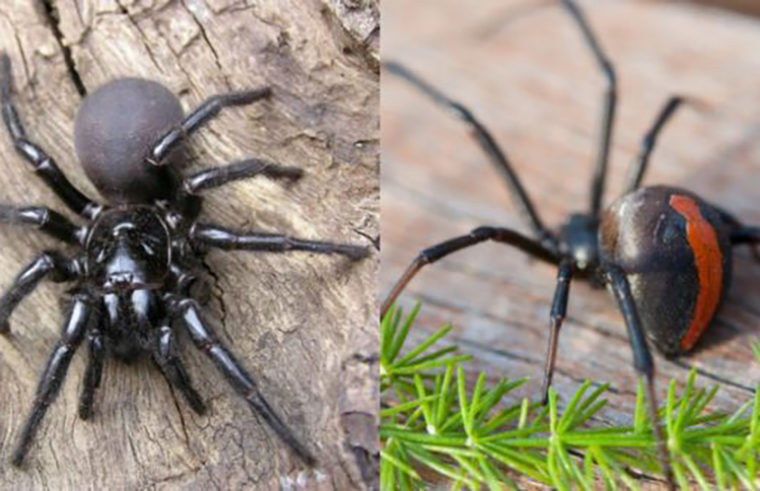Bites, stings and creepy crawly things! What to look out for with little ones

Kids just love climbing trees, hiding in bushes and rolling around on grass – ah, the perks of living in Australia. Unfortunately, we also have our fair share of bugs and creepy crawlies to watch out for. Here are the most common ones your little one might encounter outside and what you need to know when it comes to their bites and stings.

Mosquitoes
As the weather heats up children spend more time outdoors playing in the garden, camping, at barbecues or the beach and their sweetly scented blood becomes a siren call for those pesky mozzies. These annoying and itchy bites are harmless in most parts of Australia, however, in more remote and tropical parts of the country they can carry viruses or diseases, so it’s best to try and avoid your child being bitten wherever possible.
Child-friendly insect repellents are generally good deterrents (check the labels as some aren’t suitable for children under one). Citronella candles, mosquito nets over beds, fly screens and fans are also good preventative measures to take, although simply being more aware of peak mozzie times (dawn and dusk), and making sure children are covered up is the best approach. Keeping the garden tidy with no pots of water around will also help reduce mosquito breeding.
If your child does get bitten, don’t panic if the bites appear quite large – as they grow older their reaction to mosquitoes will become less pronounced. The best methods for helping ease their discomfort are applying topical creams such as calamine lotion, creams that contain lignocaine, and cold cloths or ice packs.

Bees and wasps
Being stung for the first time can be a really painful experience for little kids, even if they’re not seriously allergic to the venom. Wasps can sting repeatedly, whereas bees will only sting once and their stinger will remain in the skin, but the pain can feel the same.
If your child is stung by a bee, you should carefully scrape the stinger out with your finger nail or something like a business card – don’t pull or pinch it as this could release more venom. Then wash the area with water and apply an ice pack to reduce swelling. Apply the same treatment for a wasp sting. If your little one seems particularly distressed or in pain you can give them some paracetamol or antihistamine too, and don’t forget the cuddles and treats!

Spiders
Australia has so many different types of spiders and it can be hard to know which ones are harmless and which are potentially deadly. The key arachnids you need to watch out for are:
- Funnel webs – Large and black, they’re the most venomous and therefore dangerous spider in the world with an extremely painful and potentially fatal bite (oh Straya …). Mouse spiders look similar and are thought to have similar bite effects.
- Red backs – Not life threatening but still with a very painful bite, they’re easy to spot as they literally have a red mark on their back.
If you think your child has been bitten by a large black spider that could be a funnel web or mouse spider, this is very serious and you will need to:
- Call 000 immediately
- Keep your child as still and calm as possible
- Apply a pressure bandage – bind the limb from the bite down to the foot or hand and then back up again towards to the body
- Give CPR if required
- They will require funnel web antivenom – which is very effective for recovery if you act quickly
Luckily, all other spiders are more or less harmless with much less painful bites. Treatment for these (including Red Backs) is simply to apply a cold cloth or ice pack to the area and watch for any other symptoms. Where possible, also try and actually catch the spider so the exact species can be confirmed and appropriate treatment applied.
To avoid little ones coming into contact with spiders, keep your garden free of rubbish and other items where spiders can hide underneath, dress kids in long sleeves and pants if they’re helping you with gardening, and keep an eye on them at all times.

Ticks
Another big one for the warmer seasons is ticks. Nasty little parasites, they love hanging out in long grass and bushy trees, ready to jump onto and feed off unsuspecting human or animal hosts. Large adult ticks, particularly paralysis ticks, are the ones you really have to watch out for.
Problems associated with tick bites include:
- Minor itching and swelling (usually goes after a day or so)
- Severe allergic reaction such as anaphylaxis or paralysis (immediate medical attention is required)
- Subsequent allergy to red meat and gelatin (can develop months after the bite and can be life threatening when mammal products are consumed)
To avoid any major issues, ticks need to be discovered and removed as soon as possible. This can be done using tweezers or freezing sprays (like Wart Off), however because they bury their heads under the skin, it can make the task quite tricky. You need to be very careful because if ticks are irritated or not removed properly, they can release more allergen saliva which can be more dangerous. So if you are at all concerned, seek assistance from your doctor in removing the tick.
Prevention tips include: keeping garden grass and bushes cut short, wearing long pants and sleeves when near bush-land areas, wearing insect repellent, checking children for ticks after they’ve been outside (near trees, grass, etc.), and telling them not to scratch anything they can’t see (in case they disturb the tick).

Snakes
Snake bites are fairly rare but can be deadly if not handled appropriately. Not all snakes are venomous, but the worst slithery offenders are brown snakes, tiger snakes and inland taipan snakes. One of the trickiest parts of snake bites, such as that of a brown snake, is that often the person is not aware that they have been bitten. A child in particular may just think they have scratched their skin, which can be very dangerous as they might not get treatment fast enough.
Snakes are sneaky and like to hide in all kinds of places like piles of leaves and even inside cosy areas of the house – particularly over warmer months. If you see a snake. do not approach or provoke it, get children away from the area and call a snake handler to remove it safely. If your child is bitten, call 000 immediately and follow the same procedures as you would for a funnel web spider bite (see above).
When to panic
If your child appears to have a serious allergic reaction to any kind of bite or sting, you should seek immediate medical attention. Signs of a severe allergy include:
- hives
- difficulty breathing or swallowing
- stomach cramps
- severe itching
- coughing or wheezing
- fainting
- choking
- swelling of the lips or tongue
And if you already know that your child has an existing allergy to any of the insects or creatures above, then be sure to speak to your doctor for advice and carry any required medical equipment at all times (such as an Epi-Pen to be administered in the event of anaphylaxis).









